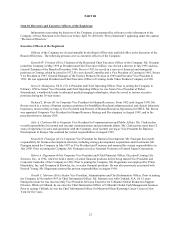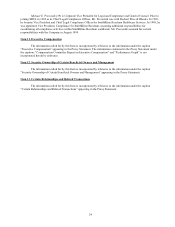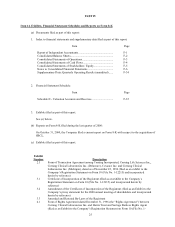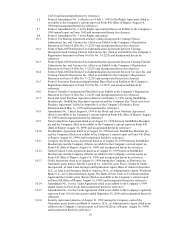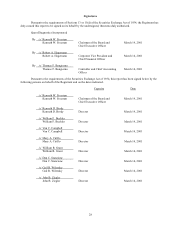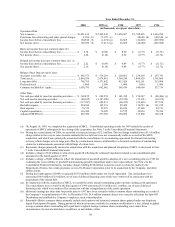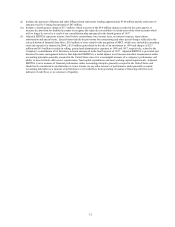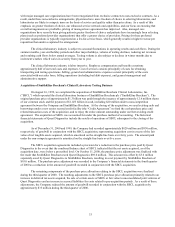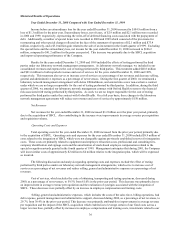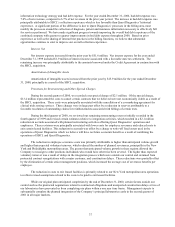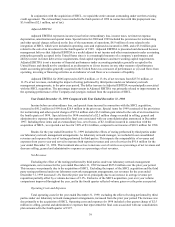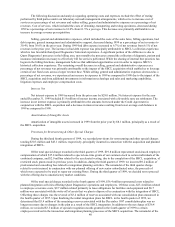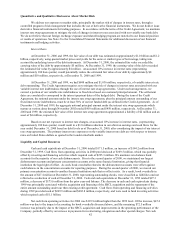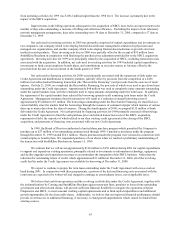Quest Diagnostics 2000 Annual Report Download - page 53
Download and view the complete annual report
Please find page 53 of the 2000 Quest Diagnostics annual report below. You can navigate through the pages in the report by either clicking on the pages listed below, or by using the keyword search tool below to find specific information within the annual report.33
with major managed care organizations have been renegotiated from exclusive contracts to non-exclusive contracts. As a
result, under these non-exclusive arrangements, physicians have more freedom of choice in selecting laboratories, and
laboratories are likely to compete more on the basis of service and quality rather than price alone. As a result of this
emphasis on greater freedom of choice, our enhanced service network and capabilities, and our focus on ensuring that
overall arrangements are profitable, pricing of managed care agreements has improved. Also, managed care
organizations have recently been giving patients greater freedom of choice and patients have increasingly been selecting
plans (such as preferred provider organizations) that offer a greater choice of providers. Pricing for these preferred
provider organizations is typically negotiated on a fee-for-service basis, which generally results in higher revenue per
requisition than under a capitated fee arrangement.
The clinical laboratory industry is subject to seasonal fluctuations in operating results and cash flows. During the
summer months, year-end holiday periods and other major holidays, volume of testing declines, reducing net revenues
and resulting cash flows below annual averages. Testing volume is also subject to declines in winter months due to
inclement weather, which varies in severity from year to year.
The clinical laboratory industry is labor intensive. Employee compensation and benefits constitute
approximately half of our total costs and expenses. Cost of services consists principally of costs for obtaining,
transporting and testing specimens. Selling, general and administrative expenses consist principally of the costs
associated with our sales force, billing operations (including bad debt expense), and general management and
administrative support.
Acquisition of SmithKline Beecham’s Clinical Laboratory Testing Business
On August 16, 1999, we completed the acquisition of SmithKline Beecham Clinical Laboratories, Inc.
(“SBCL”) which operated the clinical laboratory business of SmithKline Beecham plc (“SmithKline Beecham”). The
original purchase price of approximately $1.3 billion was paid through the issuance of approximately 12.6 million shares
of our common stock and the payment of $1.025 billion in cash, including $20 million under a non-competition
agreement between the Company and SmithKline Beecham. At the closing of the acquisition, we used existing cash and
borrowings under a new senior secured credit facility (the “Credit Agreement”) to fund the cash purchase price and
related transaction costs of the acquisition, and to repay the entire amount outstanding under our then existing credit
agreement. The acquisition of SBCL was accounted for under the purchase method of accounting. The historical
financial statements of Quest Diagnostics include the results of operations of SBCL subsequent to the closing of the
acquisition.
As of December 31, 2000 and 1999, the Company had recorded approximately $820 million and $950 million,
respectively, of goodwill in conjunction with the SBCL acquisition, representing acquisition cost in excess of the fair
value of net tangible assets acquired, which is amortized on the straight-line basis over forty years. The amount paid
under the non-compete agreement is amortized on the straight-line basis over five years.
The SBCL acquisition agreements included a provision for a reduction in the purchase price paid by Quest
Diagnostics in the event that the combined balance sheet of SBCL indicated that the net assets acquired, as of the
acquisition date, were below a prescribed level. On October 11, 2000, the purchase price adjustment was finalized with
the result that SmithKline Beecham owed Quest Diagnostics $98.6 million. This amount was offset by $3.6 million
separately owed by Quest Diagnostics to SmithKline Beecham, resulting in a net payment by SmithKline Beecham of
$95.0 million. The purchase price adjustment was recorded in the Company’s financial statements in the fourth quarter
of 2000 as a reduction in the amount of goodwill recorded in conjunction with the SBCL acquisition.
The remaining components of the purchase price allocation relating to the SBCL acquisition were finalized
during the third quarter of 2000. The resulting adjustments to the SBCL purchase price allocation primarily related to an
increase in deferred tax assets acquired, the sale of certain assets of SBCL at fair value to unconsolidated joint ventures of
Quest Diagnostics and an increase in accrued liabilities for costs related to pre-acquisition periods. As a result of these
adjustments, the Company reduced the amount of goodwill recorded in conjunction with the SBCL acquisition by
approximately $35 million during the third quarter of 2000.


